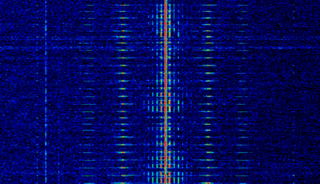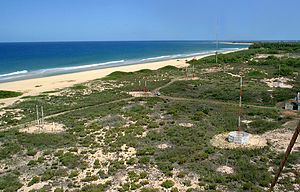
Medium wave (MW) is a part of the medium frequency (MF) radio band used mainly for AM radio broadcasting. The spectrum provides about 120 channels with more limited sound quality than FM stations on the FM broadcast band. During the daytime, reception is usually limited to more local stations, though this is dependent on the signal conditions and quality of radio receiver used. Improved signal propagation at night allows the reception of much longer distance signals. This can cause increased interference because on most channels multiple transmitters operate simultaneously worldwide. In addition, amplitude modulation (AM) is often more prone to interference by various electronic devices, especially power supplies and computers. Strong transmitters cover larger areas than on the FM broadcast band but require more energy and longer antennas. Digital modes are possible but have not reached momentum yet.

Very low frequency or VLF is the ITU designation for radio frequencies (RF) in the range of 3–30 kHz, corresponding to wavelengths from 100 to 10 km, respectively. The band is also known as the myriameter band or myriameter wave as the wavelengths range from one to ten myriameters. Due to its limited bandwidth, audio (voice) transmission is highly impractical in this band, and therefore only low data rate coded signals are used. The VLF band is used for a few radio navigation services, government time radio stations and for secure military communication. Since VLF waves can penetrate at least 40 meters (131 ft) into saltwater, they are used for military communication with submarines.

Medium frequency (MF) is the ITU designation for radio frequencies (RF) in the range of 300 kilohertz (kHz) to 3 megahertz (MHz). Part of this band is the medium wave (MW) AM broadcast band. The MF band is also known as the hectometer band as the wavelengths range from ten to one hectometers. Frequencies immediately below MF are denoted as low frequency (LF), while the first band of higher frequencies is known as high frequency (HF). MF is mostly used for AM radio broadcasting, navigational radio beacons, maritime ship-to-shore communication, and transoceanic air traffic control.

A radio clock or radio-controlled clock (RCC), and often colloquially referred to as an "atomic clock", is a type of quartz clock or watch that is automatically synchronized to a time code transmitted by a radio transmitter connected to a time standard such as an atomic clock. Such a clock may be synchronized to the time sent by a single transmitter, such as many national or regional time transmitters, or may use the multiple transmitters used by satellite navigation systems such as Global Positioning System. Such systems may be used to automatically set clocks or for any purpose where accurate time is needed. Radio clocks may include any feature available for a clock, such as alarm function, display of ambient temperature and humidity, broadcast radio reception, etc.

In radio, longwave, long wave or long-wave, and commonly abbreviated LW, refers to parts of the radio spectrum with wavelengths longer than what was originally called the medium-wave broadcasting band. The term is historic, dating from the early 20th century, when the radio spectrum was considered to consist of longwave (LW), medium-wave (MW), and short-wave (SW) radio bands. Most modern radio systems and devices use wavelengths which would then have been considered 'ultra-short'.
CHU is the call sign of a shortwave time signal radio station operated by the Institute for National Measurement Standards of the National Research Council. CHU's signal is used for continuous dissemination of official Canadian government time signals, derived from atomic clocks.
Radio VNG was Australia's national time signal service. It was inaugurated by the Australian Post Office at Lyndhurst, Victoria on 21 September 1964, although a predecessor service using the callsign VLX had begun in March 1946 alongside shortwave radio station VLR. From 1964 until 1987, Radio VNG transmitted on 4.5, 7.5 and 12 MHz from the Lyndhurst transmitters. After 1987 it relocated to Shanes Park, NSW, and transmitted on 2.5, 5, 8.638, 12.984, and 16 MHz.

BPM is the call sign of the official short-wave time signal service of the People's Republic of China, operated by the Chinese Academy of Sciences, broadcasting from CAS's National Time Service Center in Pucheng County, Shaanxi at 34°56′55.96″N109°32′34.93″E, roughly 70 km northeast of Lintong, along with NTSC's long-wave time signal BPL on 100 kHz.

WWV is a shortwave radio station, located near Fort Collins, Colorado. It has broadcast a continuous time signal since 1945, and implements United States government frequency standards, with transmitters operating on 2.5, 5, 10, 15, and 20 MHz. WWV is operated by the U.S. National Institute of Standards and Technology (NIST), under the oversight of its Time and Frequency Division, which is part of NIST's Physical Measurement Laboratory based in Gaithersburg, Maryland.
WWVB is a time signal radio station near Fort Collins, Colorado and is operated by the National Institute of Standards and Technology (NIST). Most radio-controlled clocks in North America use WWVB's transmissions to set the correct time. The 70 kW ERP signal transmitted from WWVB is a continuous 60 kHz carrier wave, the frequency of which is derived from a set of atomic clocks located at the transmitter site, yielding a frequency uncertainty of less than 1 part in 1012. A one-bit-per-second time code, which is based on the IRIG "H" time code format and derived from the same set of atomic clocks, is then modulated onto the carrier wave using pulse-width modulation and amplitude-shift keying. A single complete frame of time code begins at the start of each minute, lasts one minute, and conveys the year, day of year, hour, minute, and other information as of the beginning of the minute.
RWM is the callsign of a high frequency (shortwave) standard frequency and time signal radio station in Moscow, Russia. It is controlled by All-Russian Scientific Research Institute for Physical-Engineering and Radiotechnical Metrology, and operated by Russian Television and Radio Broadcasting Network. Transmitting frequencies are 4.996 MHz with 5 kW and on 9.996 and 14.996 MHz with 8 kW.

JJY is the call sign of a low frequency time signal radio station located in Japan.

DCF77 is a German longwave time signal and standard-frequency radio station. It started service as a standard-frequency station on 1 January 1959. In June 1973 date and time information was added. Its primary and backup transmitter are located at 50°0′56″N9°00′39″E in Mainflingen, about 25 km south-east of Frankfurt am Main, Germany. The transmitter generates a nominal power of 50 kW, of which about 30 to 35 kW can be radiated via a T-antenna.
A440 (also known as Stuttgart pitch) is the musical pitch corresponding to an audio frequency of 440 Hz, which serves as a tuning standard for the musical note of A above middle C, or A4 in scientific pitch notation. It is standardized by the International Organization for Standardization as ISO 16. While other frequencies have been (and occasionally still are) used to tune the first A above middle C, A440 is now commonly used as a reference frequency to calibrate acoustic equipment and to tune pianos, violins, and other musical instruments.

YVTO is the callsign of the official time signal from the Juan Manuel Cagigal Naval Observatory in Caracas, Venezuela. The content of YVTO's signal, which is a continuous 1 kW amplitude modulated carrier wave at 5.000 MHz, is much simpler than that broadcast by some of the other time signal stations around the world, such as WWV.
Beta is a time signal service in the VLF range in Russia, operated by the Russian Navy. It is controlled by All-Russian Scientific Research Institute for Physical-Engineering and Radiotechnical Metrology. There are 6 transmitter stations, which take turns transmitting time signals and other communications.

Yosemite Sam is the nickname given by DXers to a rumored numbers station that was heard making intermittent broadcasts between December 19, 2004 and February 16, 2005. It transmitted on several shortwave frequencies in dual side band: 3700 kHz, 4300 kHz, 6500 kHz, and 10500 kHz. The nickname is taken from the Warner Bros. Cartoons character Yosemite Sam, whose voice was always played as part of the unusual transmission.

ALS162 is a French longwave time signal and standard-frequency radio station and is used for the dissemination of the Metropolitan French national legal time to the public. TéléDiffusion de France broadcast the ALS162 time signal, provided by LNE-SYRTE and LNE-LTFB time laboratories under ANFR responsibility, from the Allouis longwave transmitter at 162 kHz, with a power of 800 kW.
HLA is a time signal radio station in Daejeon, South Korea, operated by the Korea Research Institute of Standards and Science. Established on November 24, 1984, it transmits a 2 kW signal on 5 MHz (±0.01 Hz). Originally only transmitted for 7 hours per day (01:00–08:00), 5 days per week (M–F), it is continuous as of 2011. There are over 100 users of the signal in Korea.
BSF is the callsign of the time signal transmitter owned by the National Time and Frequency Standards Laboratory of the Ministry of Economic Affairs (Taiwan), which transmits time information on 77.5 kHz in the longwave range. It was launched on May 1, 1969 and is broadcast from Zhongli District in Taichung using a T-antenna located at 25°0′20″N121°21′54″E.













